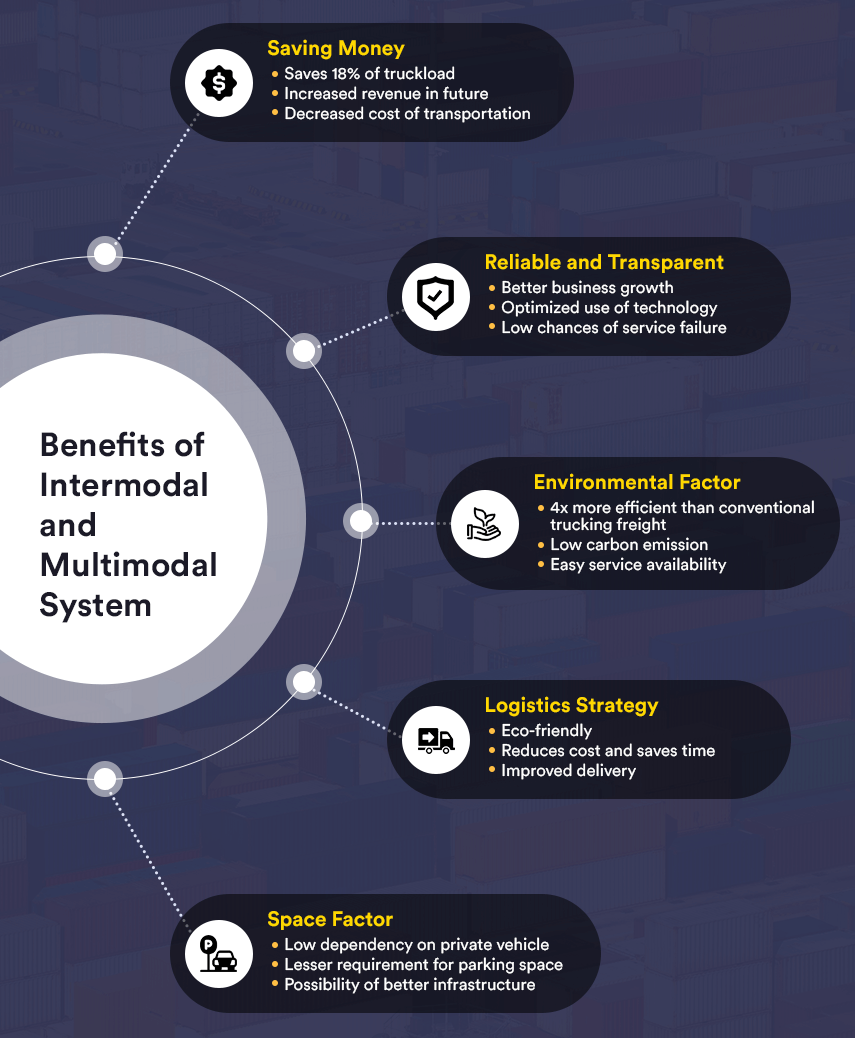In today’s smart cities, connecting destinations faster and seamlessly are the key to development. Intermodal and multimodal transportation freight methods allow better shipment or commutation even to remote areas by combining different modes of transportation, including but not limited to flight, freight, truck, and public transportation. Although used interchangeably, intermodal and multimodal transportation systems are worlds apart.
Introduction to the Concept
The efficiency of smart cities can be improved beyond expectations by crafting an optimal transport system. Every stakeholder and customer is looking for that key innovation, which puts one community or a smart city apart from the other. May it be the low carbon emission or energy efficiency, accelerating development in smart cities lies in the hands of the transportation system.
Intermodal Transport System
As the name indicates, it is a transportation system connecting two or more modes. Under this system, goods transportation takes place in an intermodal container or loading unit, which passes through several modes of transportation (ocean freight, truck, rail, etc.).
Once the product reaches a specific geographical area, trucks deliver the product to a common collection area. From there, similar vehicles or smaller transportation deliver the product to the end customer. The entire transportation process comes under the control of a different carrier or transportation service provider under different contracts. This model includes airport rail-road link transportation, airport ferry connection, allowing automobiles on trains, train to ferry connections, and so on.
In the case of urban public transport, intermodal transport is used to reduce the use of individual automobiles and promote the utilization of public transport. Several intermodal journey planners such as Rome2rio and Google Transit have taken the initiative to help travelers schedule their journey. Intermodal transport focuses on providing a blend of one type of rapid transit like the regional rail to low-speed options such as buses, trams, or bicycles. The latter is either appended at the beginning of the journey, or towards the end. Thus, trains provide a quick transit over long distances, such as from suburbs to urban areas, from where the passengers can choose the second option to travel within the city. For example, people can use trains or airplanes to cover long distances, and then pick a bus, taxi, or tram to travel from the airport to the in-city destination.
In places with dense populations and high demand for public transport networks, the intermodal transport system could be a reliable solution. By using mobility-as-a-service, it is easier to provide a digital solution to public transportation, including intermodal route planning, ticket mobility, sharing transportation, and others. Intermodal mobility allows packaging services from different types of public operators to create a holistic platform for booking, planning, and traveling. The best example of the intermodal passenger transportation is the feeder buses.

Multimodal Transport System
The multimodal transportation system has the same style of the transportation process. But, this system is more frequently used in freight transportation than public transport. However, each transportation service provider has the same bill of lading or the contract. The responsibility of the product from the origin to the end customer falls under one single carrier company. Under this concept, a service provider should have all modes of transportation. Upon receiving a project or contract, the service provider will come up with a combination of different transportation based on the route of the passenger and type of product. Once the customer approves the process, a contract is made that covers the entire process.
It has the same applications like intermodal transport. While handling people with multimodal transportation (mixed-mode commuting), the system aims to reduce the dependence of personal automobiles during the commutation, making public transportation easier to schedule any journey. For instance, regional rail would provide rapid transit at a low cost. Once the passenger reaches a suburb station, quick transit to an inner area needs road transportation like a bus.
With the help of multimodal transport systems, unified public transportation can become possible by linking several modes of public transports like buses, light rail, and metro. Such a mass transit can help to create sustainable urban mobility.
What is the Difference Between Intermodal And Multimodal Transportation?
Contract
Intermodal transportation sees each mode of transportation as a different contract. On the other hand, multimodal transportation maintains higher efficiency as the entire process comes under the monitoring radar of one single carrier. Thus, under intermodal, the product or container’s responsibility moves from one hand to other, making it challenging to maintain strict control over quality. On the other hand, multimodal has the advantage of keeping the freight under control. Creating a unified ticketing system is more accessible with multimodal transportation. However, the passengers have to take care of individual ticket purchases for each stage of transit.
Flexibility
Intermodal transportation allows the passenger or carrier contractor to choose the best of each mode of transportation. For instance, he can choose the fastest ferry service to save hours in transit and comfortable road transportation over public transportation. In multimodal transportation, the entire process is the choice or model provided to the contractor or passenger based on the service provider’s model.
Delay and Overhead
In terms of overhead and delay, the contractor should keep track of every delay and complications, in each transportation mode. For instance, if an individual is traveling from airport to a remote region, he has to take into account the delay in train arrival, match it up with boarding public road transportation, and so on. One mode of transportation will not have complete information about the complications and delays in another, which leads to incoherence in intermodal transport. However, in terms of multimodal, the entire process is under the control of one service provider, which gives ease to the contractor or service user.
Cost
Intermodal transportation deals with a new contract for every mode of transportation, which increases the overall cost of transportation for the contractor or passengers. In the case of multimodal transportation, the operation cost of setting up such a service is high, but the overall package for the user can be cost-efficient than intermodal. Multimodal transportation gives better routing efficiency than intermodal transportation.
Government Regulation
In case of both the origin and destination located in the same country, there isn’t a considerable difference in regulations of intermodal and multimodal transportation. Let’s say both points (origin and destination) are on different continents, the shipment company has to create a contract that covers the regulations of both the governments.
While dealing with international transportation, the regulations ratified on the process by each country is different. This difference increases the complexity of the contract of multimodal transportation. Some countries do not have the infrastructure to implement multimodal transportation. In such cases, intermodal transportation is the best option.
Reliability / Insurance / Claims
At each node, the carrier provides a contract of lading, which shifts the responsibility of the cargo or transportation to the next service provider, in the case of intermodal transportation. Thus, during cargo claimants, the process can become complicated and tangled into webs of conditions. The claim process can vary based on the type of bill of lading provided by each carrier service provider. Depending upon the contractual conditions and agreements, the claimant’s position will vary. In the case of multimodal transportation, one contract stands valid, and the service provider is claimable in case of any misfortunate events.
Insurance
In the case of multimodal transportation, single umbrella insurance covers every mode of transportation. The intermodal transportation increases the overall cost of operation by requiring different types of insurance for each contract. However, this individual insurance can provide better safety and security of transportation for those transporting fragile or perishable products. The overall insurance concept is quite applicable while choosing multimodal public transportation for an area or city.
Speed vs. Cost
Multimodal transportation and intermodal transportation are both efficient in terms of speed and value when compared to conventional trucking logistics. However, in an in-depth analysis of intermodal vs multimodal concepts, multimodal transportation is the best when commuters put more emphasis on speed than the cost of transportation. This reason is why multimodal transportation is the best replacement for the public transportation system. In terms of intermodal transportation, it is cost-efficient, but the pressure and complexity of intermodal routing and creating a combination of transportation modes fall on the head of the contractor or traveler, which can become a daunting process if used daily.
Why Should Private and Public Sector Stakeholders Shift to an Intermodal and Multimodal System?

1 Saving money
Under the intermodal system, the contractors can save up to 18% of the truckload, which amounts to a considerable monetary amount. Moreover, it increases the additional capacity of the service provider, showing potential savings or increased revenue in the future. Although the operational cost of the initial set up and overheads are higher in multimodal, the cost of transportation decreases. With a unified ticketing system or combined public transportation, people can save a considerable amount of money in transportation expenses.
2 Reliable and Transparency
With a robust intermodal service, the contractor can convert their shipping method to intermodal or multimodal and have significant transparency in the process. This transparency increases reliability, which is the key to business success. Moreover, the chances of service failure are reduced with the best utilization of technology.
In the case of public transport, passengers can be at more ease in multi-modal transport as the entire travel planning is facilitated by one company or planner. In intermodal, different entities come into play; thus reliability cannot be guaranteed. For instance, rapid transit such as trains might get late whereas the bus or taxi is usually on time.
3 Environmental Factor
An intermodal/multimodal train freight can carry products equivalent to 280 trucks. This efficiency makes intermodal/multimodal transportation four times more efficient than conventional trucking freight. For calculation, approximately a train emits 5.4 pounds of carbon dioxide for every 100 ton-mile. Trucks in their best-operating conditions would emit 19.8 pounds of carbon dioxide for the same ton-mile, approximately. Using intermodal or multimodal options, people can shift towards public transportation without worrying about the availability of services to remote regions. Turning towards public transportation from private is a great way to reduce carbon emissions.
4 Logistics Strategy
In many ways, rail transportation has a better value proposition than highway travel. This feature is very prominent in public transportation, where the population of commuters and the volume of products transmitted is higher and increasing every year. While scaling up public transportation, going green is also essential, especially in smart cities.
Many government policies have restricted the hours of road transportation, which puts the capacity of truck transportation under the category of restricted service. Thus, if a service provider wishes to cut costs and improve delivery time multimodal transportation is quite crucial. The passenger will have full control over choosing the style of transportation to reduce the time taken or for his comfort. This style of customizability is possible even for public transit.
5 Space Factor
By implementing intermodal and multimodal transportation into public transportation, the number of people dependent on private automobiles decreases. This decrease also reduces the space required for parking, traffic jams, and so on. When space and time taken for automobile security reduces, it becomes easier and plausible to create a much more attractive infrastructure for the proposed city.
Role of Technology
Regardless of choice between multimodal and intermodal transportation, the system needs a basic transportation management system, which includes tracking, routing, and contract management. The use of ICT (information communication technology) in intermodal and multimodal transportation methods helps in better material planning, directness, and speed in the process. ICT is a grand advancement when compared to the conventional point-to-point style of integrating separate systems along the supply chain.
Apart from these, certain technological advancements provide better utilization of resources during these transport processes.
Open Interface for User Experience
Using one simple interface linking the mobility services like public transportation, shared taxi, charging stations, and others will provide a better platform for the partners to have a heightened experience. In freight transport, this interface includes usage of the geo-localization system to track the product.
Electronic Cash
Since multiple carrier companies are involved in the entire process, usage of electronic cash or pre-paid cards can reduce the time and complexity of the process. Using integrated cards, service providers can manage the spending and redeeming credits with less complexity. This process also gives more transparency to the entire process.
Smartphone Apps
Allowing the passenger or contractor to track the route is one part of providing an application for the phones. Starting from using any electronic credits to reserving services for a future purpose, the scope of an integrated application for mobile phones is seamless. This real-time application allows the user to manage or identify the multimodality or mobility of the process with ease. For instance, with a traffic monitoring system, the passenger can get notification about a possible delay in trains and choose buses instead of trains to reach the destination.
Reducing Delays and Damages Using IoT
Using IoT, the system can track and analyze every single required parameter of the transportation process. For instance, by utilizing IoT, the system can monitor the temperature of refrigerated containers allowing immediate fix to any compressor problem in any of the refrigerated containers during the transit. The same goes for avoiding the wrong delivery of products. IoT can also help in reducing delays and incoherence between two modes of transportation.
Cloud Computing
Integrating ICT with cloud allows business service providers to respond quickly, reducing implementation and delivery time. This integration also reduces the need for drastic improvement in infrastructure while scaling up. With the help of cloud computing, the service providers can provide better features and advanced functionality to the users, in parallel to data security and reduced delay in data sharing.
Artificial Intelligence or RPA (robotic process automation)
Implementing RPA in intermodal and multimodal transportation allows the service providers to reduce the redundant manual process, allowing customers to experience prompt services. In multimodal transportation, creating coherence between two modes of transportation is very crucial. Automatic reporting and automatic notification can help you create a strict timeline, which also reduces the overall delay.
Other benefits of using advanced technology in the system are:
- Improved efficiency even during unexpected operating conditions like driver strikes.
- Reducing the number of empty runs with better routing.
- Optimized utilization of resources and infrastructure.
- Reducing the overall cost of the operation, thereby reducing the bill of transportation for each individual.
- By using advanced terminal-based ICT, the loading and unloading time decreases. It also allows for better utilization of terminal infrastructure and coordination between different service providers during multimodal transportation.
- During intermodal transportation, a centralized system for managing contracts and an automated billing process can reduce manual errors and delays in the contract of lading generation.
Wrapping Up,
Given the advantages and scope of intermodal and multimodal transportation, it is clear that one is not a direct replacement of another. For any flourishing modern city, both intermodal and multimodal systems are essential if one is looking for more efficient transportation without forgoing the green-initiative for a healthier tomorrow.



 March 4, 2020
March 4, 2020




